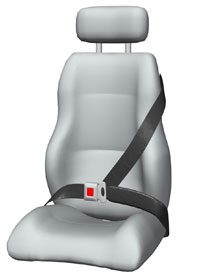
The bill would create a primary law, meaning police can stop a car and issue a summons solely for the failure to wear a seat belt. A secondary seat belt law authorizes the police to issue a summons for non-seat belt use only if the motorist has been stopped for another violation. The New Hampshire law would impose a $50 fine for a first offense and $100 fine for each subsequent violation.
A similar bill passed the House by a 13-vote margin two years ago, but was killed in the Senate 16-8. Democrats have controlled both Houses since the 2006 elections, but this year’s bill is expected to have more support in the upper chamber, with majority leader Maggie Hassan (D-Exeter) as one of the sponsors. The state’s Democratic governor, John Lynch, did not commit himself on the proposed mandate to buckle up two years ago and has not yet said whether he supports this year’s bill. The governor said he has been so focused on the state budget this year that he has not yet had a chance to look at the bill.
There seems little likelihood of a veto by the risk-aversive governor, who has maintained his approval rating of more than 70 percent in part by avoiding controversies and confrontations with the Legislature. But the Legislature has voted down several past efforts to require seat belts for adults, owing in no small part to the vocal opposition of citizens who argue that such a law needlessly meddles with the right of adults to make their own decisions regarding their own safety. But the state does have a seat belt law applying to children.
New Hampshire began with a child restraint law in 1983, which applies to automobile passengers up to the age of five. In 1989, the legislature required anyone under the age of 12 to wear a seat belt and in 1997 moved the age up to 18. But so far the state has drawn the line at requiring adults to “buckle up.” Proponents argued the state would save lives, reduce healthcare and insurance costs, and gain $3.7 million in federal grants by passing the bill. Republican Rep. Jennifer Coffey, who opposes the bill, invited fellow lawmakers to consider the possibilities of passing laws against other forms of risky behavior.
“Many die from liver failure, so I suggest we will have to bring back Prohibition,” said Coffey, who facetiously proposed “weight check stations at the borders, preventing people from entering our state if they’re obese.” That $3.7 million from the National Highway Traffic Safety Administration does depend on the passage of a seat belt law, but it won’t help lawmakers eliminate the $125 to $140 million deficit projected for the fiscal year ending June 30. The money would go to the New Hampshire Highway Safety Agency, which would be required to spend it on highway safety programs.
“None of that money goes into the general fund,” said agency director Peter Thomson, son of the late governor Meldrim Thomson. While he wouldn’t mind having more money to promote seat belt usage and other safety measures, Thomson is cool to the idea of passing a mandatory seat belt law to get it.
“I’ve never been a person who feels you have to be under the gun from the ‘feds’ to do something,” Thomson said. He said his agency has encouraged voluntary seal belt use through radio ads and school programs and the use of a machine called “The Convincer,” which simulates the impact of a crash at eight miles an hour.
“Even at that speed, you get quite a jolt,” Thomson said. “You can imagine what it’s like at higher speeds on the interstate.” Samples taken from observations done on roads and highways around the state show more than 69 percent of drivers and passengers in New Hampshire are wearing seat belts, compared to barely 16 percent when the agency began doing the surveys in 1984. While that’s lower than the national average of 83 percent claimed by the NHTSA, it’s higher than in Massachusetts and some of the other states that have seat belt laws, Thomson said. “We’re moving those numbers without a law,” he said.
According to the 2009 Statistical Abstract, published by the U.S. Census Bureau, New Hampshire is tied with Minnesota for fewest fatalities per 100 million vehicle miles traveled. Each state had 0.9 for 2006, the last year for which statistics are available.
“New Hampshire has done very well,” said Thomson. “We’ve often led the nation in lowest percentage of fatalities. Year in year out, we’ve been under 1 percentage point.”



